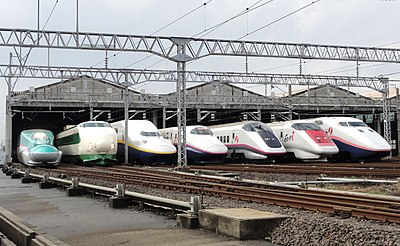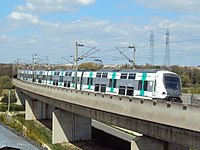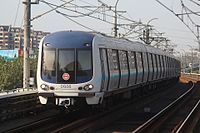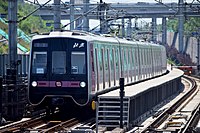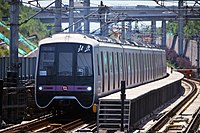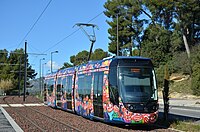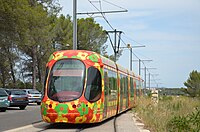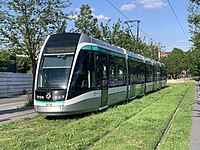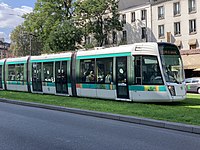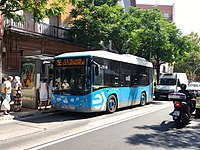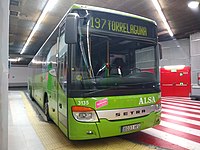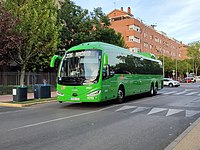United Trenchways
This article is incomplete because it is pending further input from participants, or it is a work-in-progress by one author. Please comment on this article's talk page to share your input, comments and questions. Note: To contribute to this article, you may need to seek help from the author(s) of this page. |
| Predecessors | and more |
|---|---|
United Trenchways, also called UT, is a multinational corporation composed of several infraestructure and transportation builders and operators with hub in Guri. The company was created in 1972 and today encompasses over 54 different societies across many transportation and infrastructure-related fields.
UT originated as one of the many smaller train operators that appeared in Riamo in the late 1890s, and would go on to provide service to many destinations nationwide, later including international routes on its list of clients as public transportation grew larger and larger in the mainland.
The company remains as the largest rail and transport operator and infraestructure builder of Riamo, operating more than 32 urban transportation networks across the country, as well as 2 in Krenya and several minor lines elsewhere, like L-2201 in Kentalis or the Cross-Negro lines to Gavrilia.
History
Conrail
Subsidiaries
Gassasinian Trenchways
Gassasinian Trenchways is a subsidiary of United Trenchways based in Gassasinia. It was founded in 1978 through a partnership with the local government of Basra, a satellite city of Jabiyah which would later be amalgamted into New Jabiyah. The partnership saw Gassasinian Trenchways construct railway services from Jabiyah to Basra, in return for being allowed to take ownership of the land around the tracks. As of today, the Basra City Railway boasts 2 metro lines and 2 tramway lines. In 2003, the Basra City Railway, along with the privately owned New Jabiyah Subway and the Gassasinian Railways-operated Jabiyah Subway, agreed to form the Jabiyah Metro which introduced a unified ticketing system, uniform branding, synchronised time-tables and integrated maps.
Since the liberalisation of the Gassasinian Railways rail network in 2008, Gassasinian Trenchways has provided a range of rail services as an open-access railway operator. Gassasinian Trenchways also operates services on a number of low-traffic unelectrified rural routes whose passenger operations have been outsourced. Gassasinian Trenchways also operates the TransMagrikia brand which provides budget high speed and intercity services.
Projects
Rolling Stock
This list represents a comprehensive listing of all rolling stock produced by UT and its subsidiary companies, not necessarily the one UT operates.
High Speed "Shinkansen" Rail lines
High Speed railways remain the only major notable example of non-standardised rolling stock in Riamo. Several attempts have been made since the conception of the initial Standardization Act, but private enterprises as well as multi-lateral competition have turned down all attempts. Trains tend to be between 108 and 144 meters long, with High-Speed trains using letters to help the passengers navigate the lenght of the platforms to help them find their designated seats.
While most high-speed rail lines may share portions of railway with regional and trenchway lines, HSR lines are configured and timed to have absolute priority over other passenger services, as well as cargo ones, across all the national territory. Because of the constricted speed for which some of the older tunnels and bridgeways were built, most high-speed routes can only achieve low speeds in high-speed-rail terms; a condition which has allowed for some older models to remain in operation without becoming deprecated. The constant renovation and repairs of the trains and tracks, as well as the train culture in Riamo, have further prompted older iconic trains to remain in service well past their designed lifespam.
Regional and Trenchway lines
Underground "Subway" lines
Surface "Tramway" lines
While most classes are compatible with the A3 and A5, some, specially older ones, tend to present notable differences in aspects such as floor height and car lenghts, which can cause issues regarding their accessibility in some platforms, among others.
Because of these problematics, A3 and A5 are hence the only 2 classes considered standard under current legislation, also being the only two classes allowed for new developments. The rest of classes are, as of 2022, on their way to being phased out across the country.
